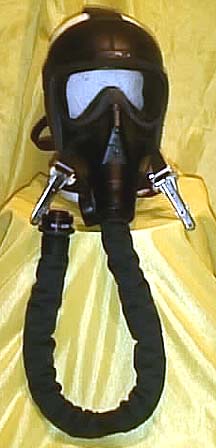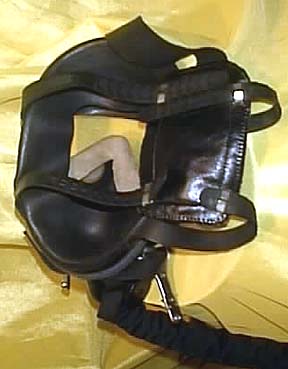

KM-35T oxygen mask
Message 2855, Jun 12, 2001
Hi Craig, Ah yes, cogent ruminations, to be sure. Your idea of the "PR" or
propaganda value of something like this (proving to the West that Russia or the Soviet
Union could match Western technology in this area) is most interesting and it wouldn't
surprise me to find that there was possibly somesuch motivation behind its development.
The mask would truly be horrifically uncomfortable to wear for long periods (as most full
face NBC masks are, of course).
As far as hoods are concerned, most of the Russian NBC masks are ostensibly to be used in
combination with a non-permeable ensemble like their OP-1 protective suit, or the
lightweight L-1 suit, both of which include a hood (see attached); the concept of issuing
a discrete hood to troops to use with another type of suit (such as the old hoodless US
activated-charcoal-lined, permeable, two-piece outfit) appears not to have put into
practice.
I'll try to shoot a few shots that show more detail and get them off to you, as suggested
earlier. No matter what the final consensus appears to be, it is without a doubt a most
interesting KM-35 type variant. I think an Austrian NBC specialist I contacted about it
referred to it by a specific ID designation, now that I think about this; I'll have to get
in touch with him and see what more information he may have on this. He seemed to be
modestly familiar with it and identified it as a Russian KM-variant for aviation NBC
applications, but I failed to follow this interesting revelation up with a request for
more detailed intelligence on the item. More after a bit. I'll send via discrete
frequency.
Cheers, DocBoink
Message 2837, Jun 11, 2001
DocB: Thanks for the complete explanation and descriptions. I would love to get some
better pictures of the mask. You can send discrete. I think the hood attachments almost
confirm that it is for NBC defense, however, and as unfortunate as it may seem, I've dealt
in Soviet and Russian NBC Masks. I've purchased more of those nasty things than I care to
talk about. However, hoods were rare items and most masks didn't come with them at all.
But then again, the cost of one grunt compared to one pilot is enough that I'm sure the
pilots received hoods.
The NBC defense upon return theory is probably most apropos, but can you imagine wearing
that beast for the duration of 1 - 1 1/2 hour flight just to have it on when you open the
cockpit at homebase? Then you couldn't leave your cockpit until you put on another mask.
This logic seems inconceivable, but the Russians are not well known for adherence to
logic. I believe that one of my guesses - that this mask was for PR (and believe it or
not, the Russians have a word "PeeArskiy" which is the adjectival form of the
words public relations, but I digress)and for public consumption only is probably right. I
don't think any Russian pilot would wear one of these things in a combat environment. They
still have their standard GP-7 gas masks, which they would wear up until they embark and
put on as soon as the deplane.
Vsego Doborogo, Craig
Message 2833, Jun 11, 2001
Spacebo Craig, Yes, the erstwhile Russian 'NBC variant' of the KM-35 appears to be quite
an interesting anomaly. I briefly discussed this with some individual Respiratory
protection contacts at Battelle and Aberdeen, asking their opinion on its possible NBC use
specificity, and the word I received initially was "Where did you get that?",
followed by uncertainty. Apparently it is not a recognizably standard item by any means,
not so much at any rate as a regular production item. Also ran this by Per-Gunner Jonsson
of FOA in Sweden, but he has no idea about its ID either (he's the chief of the FOA NBC
respiratory protection section). Hence, back to square one.
I acquired this originally with an eye to recognizing its having a definite similarity in
functional appearance to US TAERS and AERP (MBU-18/P and MBU-19/P) systems and the UK
counterpart (AR-5 system); it simply looked as if it could be for no other purpose,
especially in view of the fact that it obviously mates with a proofed hood (which I did
not get with it--however the 'Velcroski' is still on the mask facepiece, indicating mating
points for the hood in a similar manner as some US NBC system hoods). I paid a whopping
price for it, but could never find another example like it or find anyone in our US NBC
circle of specialists who could identify it for me. The facepiece has been purposefully
molded onto the KM-35 shell and is not a make-shift job, but a factory produced item. The
two pictures I attached to my email message to you were taken by the original owner. I
have not yet taken a series of suitable shots of it, but will do so at my earliest
convenience and forward them to you. I should have done this much earlier but I am easily
side-tracked by my many concurrent projects these days.
I cannot imagine that this is a Russian smoke-protective 02 mask, although that
possibility did cross my mind. The attachment points for a proofed hood rather reduced
that possibility significantly, at least in my opinion, since smoke-masks do not usually
use or even need hood accessories.
As per the fact that fast moving air removes toxins and NBC contaminants from the outer
surface of an aircraft, I think one of the major concerns for aircraft NBC systems has
always been not as much that part of the mission envelope wherein the aircraft is moving
rapidly through a contaminated area, but rather that portion of the mission wherein the
possibility of the return or landing area being contaminated is extant, requiring
protection for aircrew removal from the sealed and protected aircraft system to an outside
individual or collective protection system. In the US, our aviation NBC systems are
configured as much for this specific scenario, as for actual in-flight protection.
At any rate, this is quite an interesting little find and I certainly will be interested
in learning more about it and its intended function, as I will be in anything you are able
to find out about it. More on this tomorrow, hopefully.
Cheers, DocBoink
Message 2828, Jun 11, 2001
DocB: The NBC O-2 mask seems like quite the anomaly to me. They have not mass produced
these things, otherwise I would have seen one around somewhere. What makes it so unique is
that the Russians don't really believe that their jets are truly susceptible to NBC
attacks. In tests, chem & bio agents are stripped from an aircraft due to wind speed.
Even a speed as slow as that of a helicopter was enough to strip off any toxicity. The
KM-35 is used only in fast movers and they have sealed life support systems. If the pilot
were to use the KM-35M outside of the aircraft for NBC protection, then he'd have to have
an oxygen source with him. It goes against Russian reasoning to create an NBC variant of
the KM-35.
NBC in Russian is RBKh (appropriate cyrillic, of course). Where did you get the
information that this was an NBC defense mask and not simply a new variant for
high-altitudes? I have not seen a GSh-6 in use in quite some time. The test pilots are now
wearing the ZSh-9, it appears, which goes with the KM-34D series II or KM-35 masks.
Thanks for the picture, and with your permission, I'll add it to my web page. I will note
that it was originally identified as an NBC variant, but I will also not be skeptical
without seeing something in writing from an official Russian source.
My highest regards to all members of the flight gear forum, Craig
Message 948:
Holdek: Attached photos show a very rare and unusual Russian NBC protection aviation mask.
It is similar in concept to the USAF TAERS and MBU-19/P NBC aviator's facemasks, and
intended to mate to a 'hook & loop' attached proofed-hood (with Velcroski?). I would
certainly appreciate your keeping an eye open for one or more of these interesting masks
for me. I already have one of them but I am sure that they may be a few more floating
around, there in Moscow. The apparatus appears to use a KM-35 style 02
mask shell and hose assembly that is permanently bonded (molded) to the
rest of the facepiece. I was told this is ID'd as the "KM-35 variant T" mask
(for NBC aviation protection), but this may not be absolutely correct. One of my chief
areas of special interest is aviation NBC protection. As Norman Schwartzkopf probably
never said, "Tanks a lot." Cheers, DocBoink (AKA: Chris
Carey)

